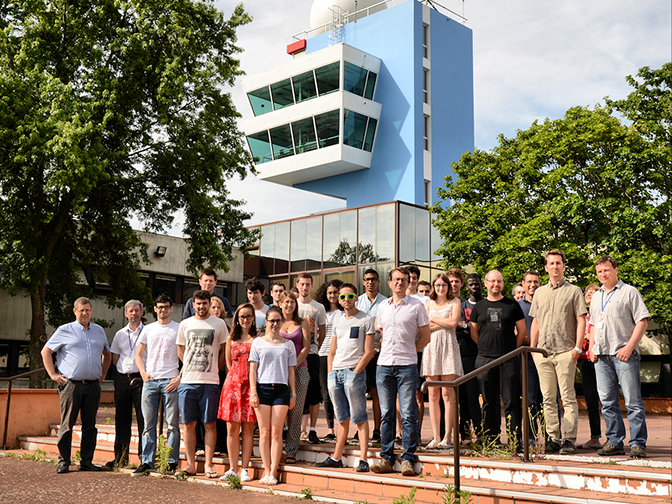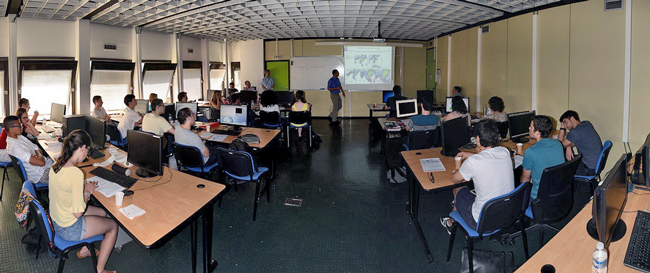

Twenty-two postgraduate students from France’s École Nationale de la Météorologie (ENM) used ECMWF’s OpenIFS model in a workshop on ensemble forecasts held in Toulouse from 7 to 9 June.
Historically, ECMWF’s Integrated Forecasting System (IFS) is closely connected to France: it has been and continues to be developed in close collaboration with scientists at the French national meteorological service, Météo-France, which runs the ENM.
The training event gave the students an opportunity for hands-on experience with a leading global numerical weather prediction system.
“Together with the teaching staff at the ENM we developed a case study for their students, using the same pedagogical approach and tools we had successfully used in previous workshops,” says Dr Glenn Carver, who leads OpenIFS activities at ECMWF.
“Interesting and enjoyable”
The topic this year was operational forecasts for the north-western Mediterranean in September 2012, during the multi-disciplinary field campaign HyMeX (Hydrological cycle in Mediterranean experiment).
The presence of Hurricane Nadine in the Atlantic caused high uncertainty for medium-range forecasts. The production of multiple forecasts, known as ensemble forecasting, allows model and initial uncertainty to be accounted for in the forecast.
The ECMWF operational ensemble forecast of 20 September 2012 produced a bifurcation in the ensemble spread. This caused difficulties in planning flights to intercept high precipitation events for the first special observation period during HyMeX.
The students explored the event using ECMWF analyses and forecasts with Metview, ECMWF’s meteorological workstation application.
“We created custom visualisation and data analysis tools to allow the students to investigate their ideas”, says ECMWF’s Sándor Kertész.

Key to understanding the bifurcation in the ensemble was the predicted separation between Hurricane Nadine and an Atlantic cut-off low, which had an impact on predicted precipitation in southern France. These charts of potential vorticity (PV) at the 320 Kelvin potential temperature level show an ensemble member which correctly simulates the observed weak interaction between the hurricane and the Atlantic cut-off low (left), another ensemble member which simulates a strong interaction case (right), and the verifying analysis (middle).
Etienne Chabot (ENM), the forecaster on duty for HyMeX at the time, notes that “this was a very interesting case for the students to study because they could see the difficulty in taking a binary decision – whether or not to send out a research aircraft – in an uncertain situation”.
“They had to assess a range of complex ensemble statistical products to try to estimate the uncertainty in their forecast in the medium range over south-eastern France.”
Frédéric Ferry from the ENM notes that the workshop complemented and increased the students’ understanding of the use of ensembles in real-world forecasting. “Feedback from the participants has been very positive and they all found it interesting and enjoyable.”
OpenIFS
OpenIFS provides a supported, easy-to-use version of ECMWF’s operational Integrated Forecasting System (IFS) model under license to national meteorological and hydrological services, research institutes and universities.
In previous years, similar workshops using OpenIFS were organised by the universities of Helsinki, Stockholm and Oxford.
“An important part of OpenIFS activities is the scientific outreach represented by the annual workshops held in institutions in ECMWF’s Member States,” Dr Carver says.
This year’s workshop was held in France at the invitation of Frédéric Ferry, supported by his colleagues Etienne Chabot and David Pollack.

The workshop took place on a campus that brings together the ENM and several other branches of Météo-France. (Photo: Sébastien Laflorencie)
The ENM is a department of Météo-France dedicated to providing higher education and professional training in meteorology and related sciences.
Mr Ferry explains that the ENM is part of a larger campus in Toulouse, “unique in Europe”, which includes the Météo-France operational branches of forecasting, observation, IT, business, climatology, research and training, together with the European Centre for Advanced Research and Training in Scientific Computing (CERFACS) and the French Central Service for Hydrometeorology and Support for Flood Forecasting (SCHAPI).
ECMWF and Météo-France have a long history of successful collaboration, particularly in research and development.
OpenIFS can help to strengthen these ties in the field of advanced-level teaching and training.
“This workshop is something we would like to repeat with the OpenIFS team in the future,” Mr Ferry says.
Top photo: OpenIFS 2016 workshop group photo (Sébastien Laflorencie)
